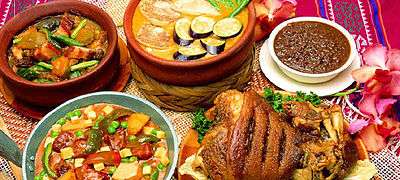Lambanog
Lambanóg is a traditional Filipino distilled palm liquor made from coconut or nipa palm sap. It is derived from tubâ (palm toddy) that has been aged for at least 48 hours. It originates from Luzon island in the northern Philippines. It is commonly described as "coconut vodka" due to its clear to milky white color and high alcohol content. It is particularly potent, having a typical alcohol content of 80 to 90 proof (40 to 45% abv) after a single distillation; this may go as high as 166 proof (83% abv) after the second distillation.[1][3] Its smoothness has been compared to that of Japanese sake and European schnapps.[2]
 Bubblegum-flavored lambanog | |
| Type | Palm liquor |
|---|---|
| Country of origin | Philippines |
| Region of origin | Luzon |
| Alcohol by volume | 40–45%[1][2] |
| Ingredients | Coconut or nipa palm sap |
History
.png)
.png)
Tubâ (the native palm wine) has existed in the Philippines since pre-colonial times. They were widely consumed for recreation as well as play an important role in the animist religious rituals presided by babaylan shamans. Heavy consumption of tubâ and other alcoholic beverages in the Philippines were reported by early Spanish colonizers. Social drinking (tagayan or inuman in Tagalog and Visayan languages) was and continues to be an important aspect of Filipino social interactions.[4][5][6]
During the Spanish colonial period, distillation technologies were adopted by native Filipinos as early as 1574, resulting in the lambanóg (known previously in Philippine Spanish as vino de coco or vino de nipa), a palm liquor derived from tubâ. There were hundreds of local distilleries for lambanóg production, largely improvised. They varied from portable stills with around 20 L (0.020 m3) capacity, to large stills that can process 750 L (0.75 m3). They usually consisted of two large pans (kawa), a hollowed out log, and a bamboo tube. One pan was filled with the tubâ and set on the fire. The hollowed out log was placed in between, acting as the walls of the still. The second pan was then placed on top of the wooden cylinder and constantly filled with cold water to induce condensation. A bamboo tube was attached to the wooden cylinder to collected the distillate to containers. Larger stills were barrel-like and made from planks reinforced with rattan hoops. The joints of the still were sealed with clay or rags. The entire upper part of the apparatus was usually connected to a lever that allowed them to be swung aside to refill or clean the lower pan.[4]
During the American colonial period, the Food and Drugs Board of the Philippine Islands set up regulated distilleries for lambanóg with modern equipment. Home production of lambanóg was made illegal, as unregulated production can result in the retention of toxic levels of methanol due to improper procedures. They also standardized the trade name of lambanóg to "Philippine palm brandy" (also "Philippine coco palm brandy" or "Philippine nipa palm brandy"). This was due to the fact that they were distilled (and thus not wines); as well as concerns about the local prejudice against "native drinks" (which are generally known as vino or bino) which could affect their marketability.[4]
Description
Lambanóg has a very high alcohol content of 40%-45% abv (80 to 90 proof), in comparison to bahalina (10%-13% abv) and tubâ (2% - 4% abv).[2] Lambanóg is usually served pure, though it can also be traditionally flavored with raisins. Modern lambanóg has recently been marketed in several flavours such as mango, blueberry, pineapple, bubblegum and cinnamon in an effort to appeal to all age groups.[7]
Production
Lambanóg production was traditionally centered in the Southern Tagalog region. The current main producing areas are the provinces of Quezon, Laguna, and Batangas, where coconuts are a dominant agricultural crop. Most lambanóg producers are small-scale cottage industries with only around 4 to 25 employees. Quezon is the leading producer of lambanóg, hosting the three largest lambanóg distillers of the country: Mallari Distillery, Buncayo Distillery, and Capistrano Distillery.[8]
Safety
Unregistered lambanóg production is illegal in the Philippines under regulations by the Food and Drug Administration and the Department of Agriculture. Consumers are warned to only purchase lambanóg that is properly sealed and made by companies registered with the FDA. Several deaths still occur each year from methanol poisoning after drinking lambanóg moonshine or adulterated lambanóg from retailers.[9][10]
In December 2019 at least 11 people died and in excess of 300 treated after drinking home-brewed lambanog coconut wine in Laguna and Quezon, two provinces south of Manila.[11]
See also
References
- Goco, Nico. "5 Reasons Why We Should Care About Lambanog". Pepper.ph. Retrieved 21 April 2019.
- Sanchez, Priscilla C. (2008). Philippine Fermented Foods: Principles and Technology. UP Press. pp. 151–153. ISBN 9789715425544.
- "How Tuba and Bahalina, Also Known as Coconut Wine, Are Made". Delishably. Retrieved 21 April 2019.
- Gibbs, H.D.; Holmes, W.C. (1912). "The Alcohol Industry of the Philippine Islands Part II: Distilled Liquors; their Consumption and Manufacture". The Philippine Journal of Science: Section A. 7: 19–46.
- Lasco, Gideon. "Tagay: Why there's no Tagalog word for "cheers" and other notes on Filipino drinking culture". Health, Culture, and Society in the Philippines. Retrieved 6 May 2019.
- Garcia, Lawrence. "Tagay: A Look at Philippine Drinking Culture". Humaling. Retrieved 6 May 2019.
- Lambanog: a Philippine drink, TED Case Studies #782, 2005
- Ascan, Tricia C.; Zapata, Normito R., Jr.; Agapay-De Jesús, Hannah Aesa S. (2010). "Status and strategic directions of the lambanog wine processing industry in Liliw, Laguna, Philippines" (PDF). Journal of the International Society for Southeast Asian Agricultural Sciences. 16 (2): 39–52.
- Galvez, Daphne (11 December 2018). "FDA orders seizure of unregistered 'lambanog' products". Philippine Daily Inquirer. Retrieved 6 May 2019.
- Guzman, Jimmyley E. (12 December 2018). "Public warned to buy only FDA-registered Lambanog". Philippine Information Agency. Retrieved 6 May 2019.
- "Eleven dead, 300 treated after drinking coconut wine in Philippines". Reuters. December 22, 2019. Retrieved December 23, 2019.
